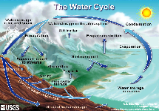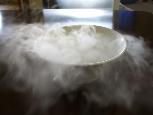

The Water Cycle
| Portal | Home | Information | QuickFacts | Links | Privacy © 2008-2010 H2O - CONTACT WEBMASTER REGARDING THIS SITE |
Most of us have probably heard of and learned about the water
cycle. On this page you will find a brief overview, along with some
extra details you might not know!
The water cycle is also called the hydrologic cycle. Basically, it
involves three steps: water collected in an ocean or other source
evaporates into the air and becomes clouds; the water then gathers
together to become heavy enough to fall as rain. The rainwater
eventually collects in pools of water which evaporate again. This is a
cycle, so it always continues - water never stops moving, although later
you'll learn how old your drinking water may be.
cycle. On this page you will find a brief overview, along with some
extra details you might not know!
The water cycle is also called the hydrologic cycle. Basically, it
involves three steps: water collected in an ocean or other source
evaporates into the air and becomes clouds; the water then gathers
together to become heavy enough to fall as rain. The rainwater
eventually collects in pools of water which evaporate again. This is a
cycle, so it always continues - water never stops moving, although later
you'll learn how old your drinking water may be.
The Water Cycle
A detailed image of the water
cycle, showing the many ways
in which water travels.
(public domain image)
A detailed image of the water
cycle, showing the many ways
in which water travels.
(public domain image)
Evaporation
The "first" step in the water cycle is when water in oceans, lakes, or
other bodies/collections of water is warmed up by the Sun. Heat adds
energy to matter. This causes the molecules in the water to move
faster and farther apart, until they move so far apart that they become
a gas instead of a liquid - the water becomes water vapour.
Condensation
Eventually the water vapour condenses into clouds. This means
that the particles in the water vapour slow down and cool off, resulting
in them becoming water droplets. These water droplets group together
to form clouds. This is why a parachutist unfortunate enough to fall
through a cloud would end up covered in water droplets (a brief
description of why the water clumps together can be found on the
chemistry page).
that the particles in the water vapour slow down and cool off, resulting
in them becoming water droplets. These water droplets group together
to form clouds. This is why a parachutist unfortunate enough to fall
through a cloud would end up covered in water droplets (a brief
description of why the water clumps together can be found on the
chemistry page).
Precipitation
When enough water droplets (remember, these are usually very
small to begin with) form 'inside' clouds, they become heavy enough to
fall towards the Earth. This is usually observed as rain, but Precipitation
can also occur as snow, hail, sleet, etc., depending on temperatures
and humidity.
small to begin with) form 'inside' clouds, they become heavy enough to
fall towards the Earth. This is usually observed as rain, but Precipitation
can also occur as snow, hail, sleet, etc., depending on temperatures
and humidity.
Collection (Runoff)
Runoff is when water travels across land. Rain will land in the
ground, streets, oceans, and in streams and rivers. Eventually it makes
its way to a body of water (not necessarily an ocean, these can be
streams, puddles, even a glass of water you leave outside). After a
while, the water is evaporated and the water cycle repeats.
ground, streets, oceans, and in streams and rivers. Eventually it makes
its way to a body of water (not necessarily an ocean, these can be
streams, puddles, even a glass of water you leave outside). After a
while, the water is evaporated and the water cycle repeats.
Other
Although the processes mentioned above are the most common,
there are other parts to the water cycle. These include:
Snowmelt
"Snowmelt" is when snow melts into water, and is a form of runoff.
Sometimes extreme snowmelt results in flooding.
Sublimation
Sublimation is when a solid turns directly into a gas, instead of first
becoming a liquid. In the water cycle, this is seen when ice or snow is
heated up enough to turn directly into water vapour. See the image
on the right for an example.
there are other parts to the water cycle. These include:
Snowmelt
"Snowmelt" is when snow melts into water, and is a form of runoff.
Sometimes extreme snowmelt results in flooding.
Sublimation
Sublimation is when a solid turns directly into a gas, instead of first
becoming a liquid. In the water cycle, this is seen when ice or snow is
heated up enough to turn directly into water vapour. See the image
on the right for an example.
Sublimation
Sublimation is when a solid
turns directly into a gas. In this
photo, dry ice is subliming into
water vapour.
(public domain image)
Sublimation is when a solid
turns directly into a gas. In this
photo, dry ice is subliming into
water vapour.
(public domain image)
"Age" of Water
One thing that many people don't realise is how old water is.
Scientists agree that matter (usually) cannot be created or destroyed.
So essentially, the water you drink today has been in the water cycle
for a very long time. In fact, it's thought that a water molecule can
spend 3,200 years in an ocean before repeating through the water
cycle and up to 10,000 years for water stored in caves deep
underground.
Scientists agree that matter (usually) cannot be created or destroyed.
So essentially, the water you drink today has been in the water cycle
for a very long time. In fact, it's thought that a water molecule can
spend 3,200 years in an ocean before repeating through the water
cycle and up to 10,000 years for water stored in caves deep
underground.
Please visit the links page for a list of websites where you can learn
more information about the water cycle, and many other topics related
to water.
more information about the water cycle, and many other topics related
to water.


